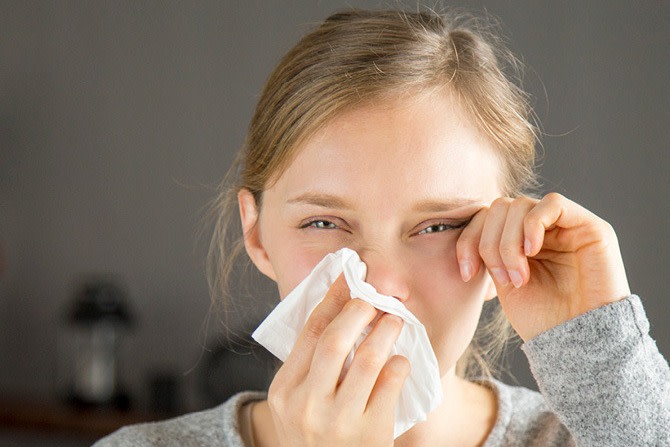How to Treat Eye Allergies

Individuals often seek help for allergy symptoms such as sneezing, coughing, a runny nose or a sore throat. In many people, allergies can also affect the eyes. Seasonal allergies and other allergic reactions can cause your eyes to swell, burn, and itch. Treating eye allergies has evolved over the recent years, making it easy to get the correct treatment. In extreme cases, an eye allergy can be an ocular emergency.
There are many things that can trigger eye allergy symptoms. Dust mites, mold spores a high pollen count in the air or even your pets can trigger allergic reactions that may affect the eyes. Luckily, there are several ways to treat these allergies and alleviate the symptoms.
Common Triggers for Eye Allergies Allergies
Like most allergies, Eye allergies occur when your body overreacts to something. When you come in contact with an allergen, your immune system will release a chemical called histamine. This will cause your blood vessels to swell and your eyes to become red, itchy, and watery. There are two types of allergies: seasonal and perennial.
Seasonal allergies are more common than perennial allergies. These allergies typically only occur at certain times of the year. Triggers are the allergens in the air such as pollen from ragweed or grass from the outdoors. Perennial allergies happen year-round. The major causes come from dust mites, pets, dust, or indoor mold.
Allergy Symptoms
Some signs of allergic conjunctivitis include symptoms like:
A strong burning sensation
Itchy eyes
Red eyes
Puffy eyelids
Tearing
Other allergy symptoms can include runny nose, sore throat, or coughing.
To determine whether you have allergic conjunctivitis, an eye doctor can take a full history and examine your eyes. You may need to see your primary physician for allergy testing to help find out what you're allergic to.
Avoiding Common Eye Allergy Triggers
One of the best things you can do is to try to avoid the trigger entirely. It can be easier to avoid contact with things that trigger allergies, like pet dander from animals Pollen, however, is much more difficult to avoid as it is in the outside air. To reduce your exposure to high pollen levels, it is best to stay indoors as much as possible, keep windows closed, and use air conditioning in spring and summer.
The same goes for mold spore allergies, allergens that activate on rainy days. It is recommended to not go out on rainy days as spores are likely to trigger allergies in the outside air.
Avoiding indoor allergens can be difficult. Staying clear of dust mites may mean replacing dust-collecting drapes or getting furniture made of leather or vinyl instead of cloth material. You could also try steam cleaning carpets and making sure bedding and clothing are washed in hot water regularly.
Eye Allergy Treatments
Over-the-counter treatment can give short-term relief to some eye allergy symptoms. While prescription treatment can provide both short and long-term help. Some quick relief treatments we recommend include:
Washing your face after contact with an allergen
Wash your clothes and bedding frequently
Keep your contact lenses and lens case clean
Shower before bedtime
Use a cool compress to soothe your eyes
Use artificial tears to lubricate the eye surface and clear out allergens
Avoiding irritants such as cigarette smoke
Using over-the-counter treatments, such as antihistamine or decongestant eye drops, or even oral antihistamines. Keep in mind that while oral antihistamines can be great for immediate relief, they can ultimately dry out your eyes.
For more intense allergic reactions, your eye doctor may recommend a prescription. These commonly include:
Steroid eye drops to reduce swelling in the eye
Mast-cell stabilizing eye drops can keep symptoms at bay by preventing the eyes from releasing histamines in the first place. These are usually only available with a prescription and include drugs called Alomide® (lodoxamide), Alocril® (nedocromil sodium), Alamast® (pemirolast potassium), and Crolom® (cromolyn). These work best when taken weeks before the start of seasonal allergies. Some newprescription drugs combine antihistamines with mast cell stabilizing drops. These include Elestat® (epinastine), Zaditor® (ketotifen), or Patanol® (olopatadine hydrochloride). These drops stabilize symptoms against itching, redness, burning, and tearing symptoms.
Common Eye Allergy Conditions
For some individuals, allergies can produce mild to no symptoms. For others, reactions may be more severe. Here are a few conditions you shouldn’t ignore:
Allergic Rhinitis – also known as hay fever – is an allergic reaction that affects the nose, causing symptoms like sneezing, congestion, an itchy nose, and a sore throat.
Dry Eye is a common condition that occurs when tears can’t provide enough lubrication for your eyes. This tear instability will lead to inflammation and damage to the eye’s surface.
Pink Eye (seasonal allergies conjunctivitis) is an inflammation of the transparent membrane that lines your eyelid. Pink eye is typically caused by bacteria, allergic reaction, or – in babies – an opened tear duct.
If you notice any of these symptoms occurring, contact an eye care professional at Nationwide Vision.
Schedule an Eye Appointment at Nationwide Vision
In many cases, avoiding common triggers and dealing with allergic conjunctivitis will become second nature to you. Though irritating, with all the treatments available, any allergy-induced discomfort can likely be overcome. If you are noticing any signs of allergic conjunctivitis, reach out to your local eye care expert at Nationwide Vision. Schedule your appointment today!